Growing herbs indoors – how to grow a windowsill herb garden
Find advice on growing herbs indoors, whether in a windowsill herb garden, in pots, or using grow lights
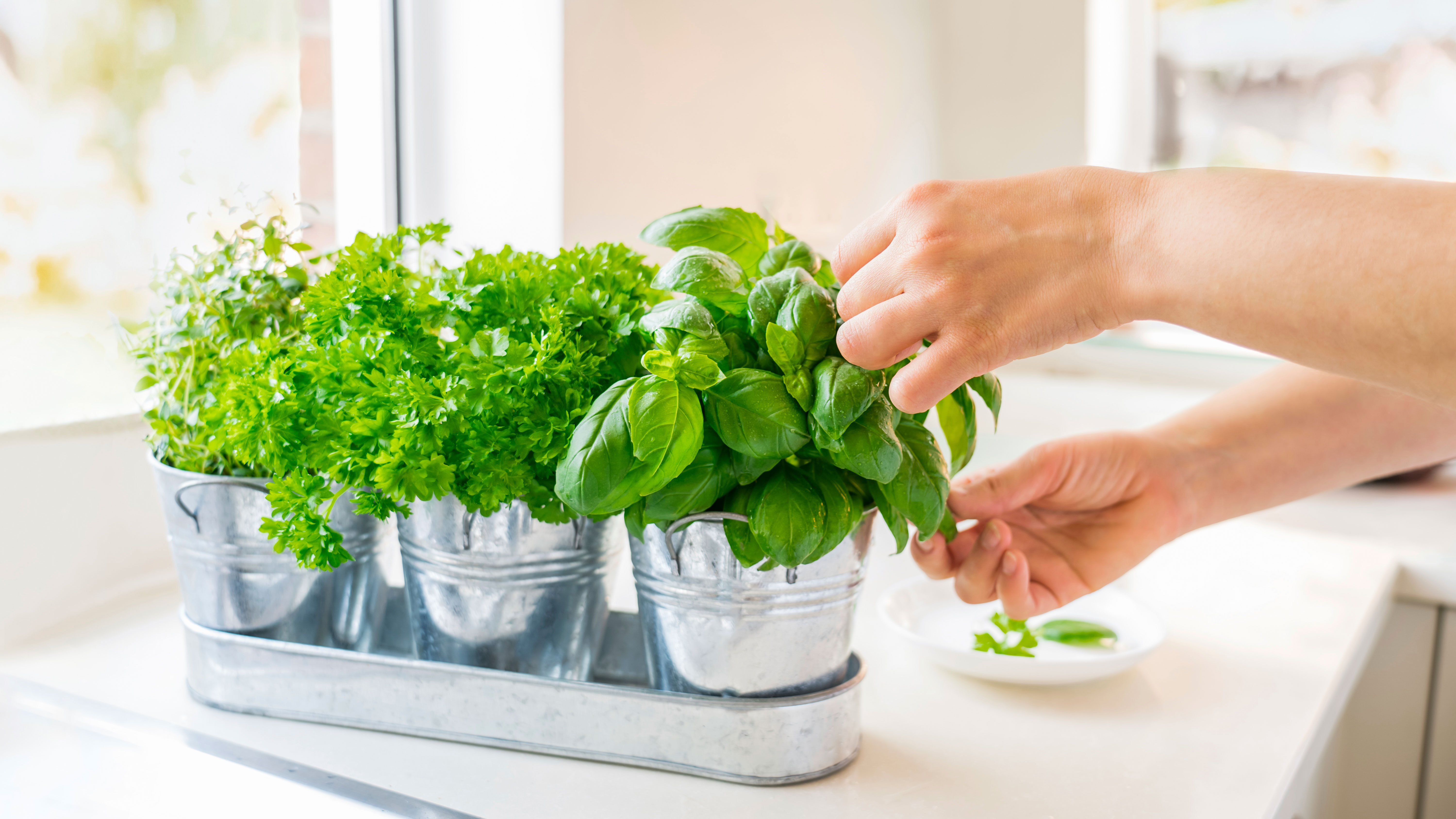

Growing herbs indoors is the perfect way to ensure a year round supply of your favorite culinary herbs – but they also offer myriad leaf shapes, colors, textures and fragrances for creating delightful potted displays.
If you have little or no space for outdoor herb garden ideas, then you can quickly master growing herbs indoors. Whether you want to grow a windowsill herb garden in your kitchen for use in cooking, would like to keep aromatic herbs, such as a lavender plant in your bedroom to aid sleep, or a container of scented lemon balm in the hallway to welcome in guests, this advice will help you do so successfully.
Growing and using herbs for their therapeutic properties is also becoming more popular. 'You can grow plants for herbal infusions easily, such as using the leaves of mint for easing upset stomachs, stimulating digestion and easing bloating,' says Jekka McVicar of Jekka's family run herb farm.

How to start growing herbs indoors
There are a number of options for growing herbs indoors, including:
- Growing herbs from seed
- Starting off with young herb plants
- Growing herbs from cuttings
- Using grow lights
- Growing herbs in water rather than soil
'Many herbs are happy to be potted and grow in a windowsill herb garden providing they have access to sunlight and receive the right amount of water and nutrients as needed,' explains Sandra Nanka, herb expert at Mudbrick Herb Cottage.
What is the best way to grow herbs indoors?
One of the best ways and easiest ways for growing herbs indoors is to start with young plants.
'Starting with young plants gives us an instant gratification and allows us to start harvesting fresh herbs quicker,' says Amy Enfield, Horticulturist for Bonnie Plants.
Design expertise in your inbox – from inspiring decorating ideas and beautiful celebrity homes to practical gardening advice and shopping round-ups.
Perennial herbs, such as mint, rosemary, sage, thyme and oregano are easiest to grow from young plants.
There are many herb planter ideas and pots for windowsill herb gardens that can complement your interior scheme, or you can create a vertical display on shelves or in hanging baskets. Glazed pots are ideal for growing herbs indoors. Clay or terracotta pots tend to dry out quickly, especially in the winter.
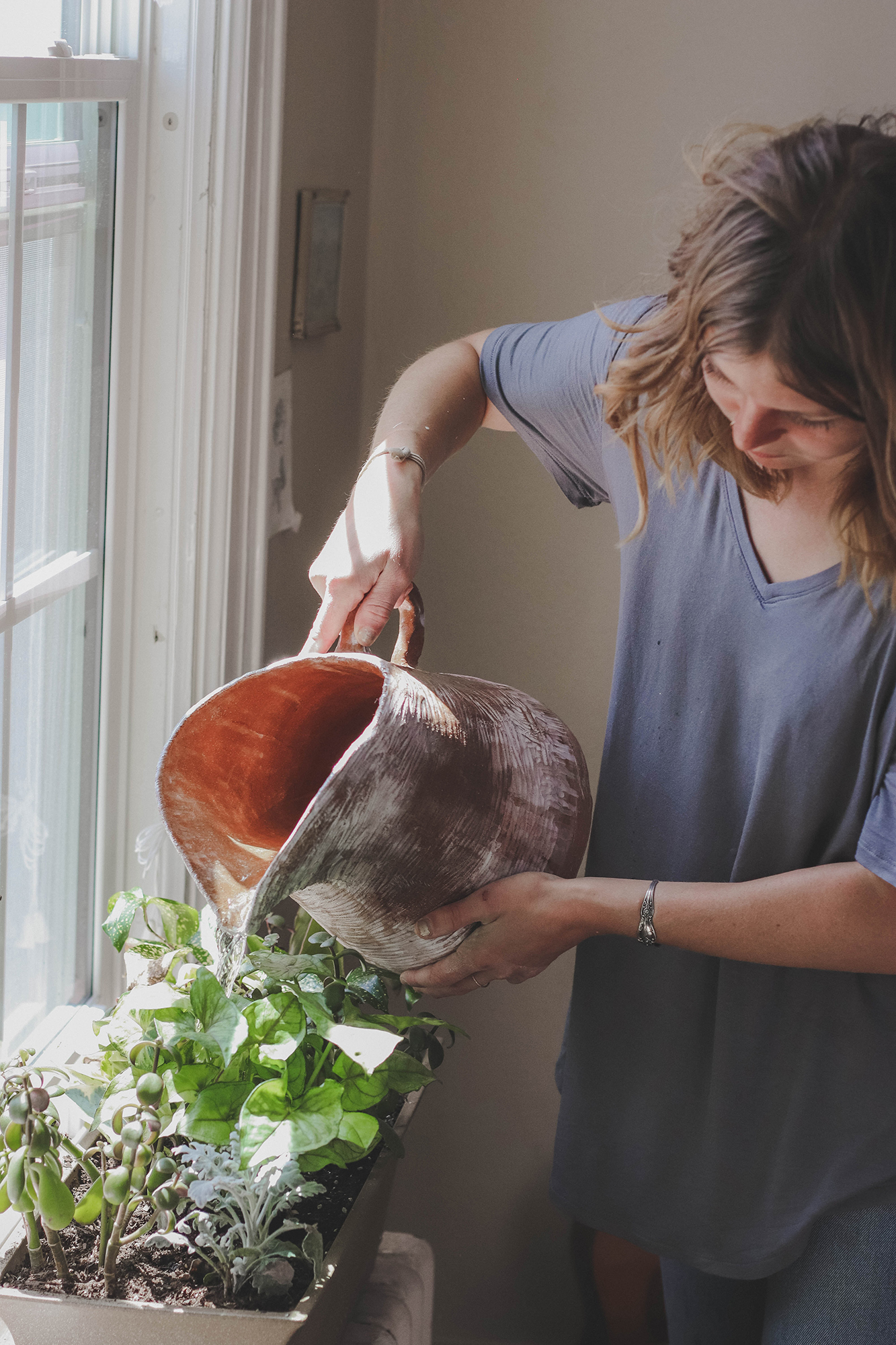
'Herbs need room to grow, so make sure to select a container that gives them some space,' explains Amy Enfield of Bonnie Plants.
'For most herbs, a 6in container will work fine. Make sure it has drainage holes, as herbs hate sitting in water as this will cause their roots to rot. To protect your tabletop or windowsill, make sure you also have a water collection tray to sit underneath your plant,' adds Amy.
'When planting herb plants in containers, only use a soil mix that is designed for indoor containers,' advises Shannon Caringi founder of Trillim Living.

What herbs grow easily indoors?
There are many herbs that grow easily indoors, and some herbs grow better indoors than others.
'Because of the reduced light levels indoors, herbs that grow well in partial sun outdoors are the best options to grow indoors,' explains Amy.
Among the easiest herbs to grow indoors are:
- Chives
- Lemon balm
- Mint
- Greek oregano
- Parsley
- French tarragon
- English thyme
- Bay
- Basil
'These herbs will grow well on a windowsill and will last longer and won’t be as “leggy” – or stretched,' says Amy.
'If you find yourself short on bright, sunny south-facing windows, or don’t have grow lights, it might be best to avoid basil, cilantro (coriander), dill, and chamomile,' Amy adds.
Herbs that grow well on sunny, south-facing window, are those that prefer full sun. If you have a spot in your house that gets a lot of direct sunlight, rosemary and sage are good windowsill herb garden options.
'Some of my favorite herbs for a windowsill herb garden include pizza thyme, otherwise known as Italian thyme, as it thrives in full sun; sweet basil, as it's very sensitive to frost and colder temperatures; and white sage, which requires full sun, airflow and excellent drainage,' suggests Sandra Nanka of Mudbrick Herb Cottage
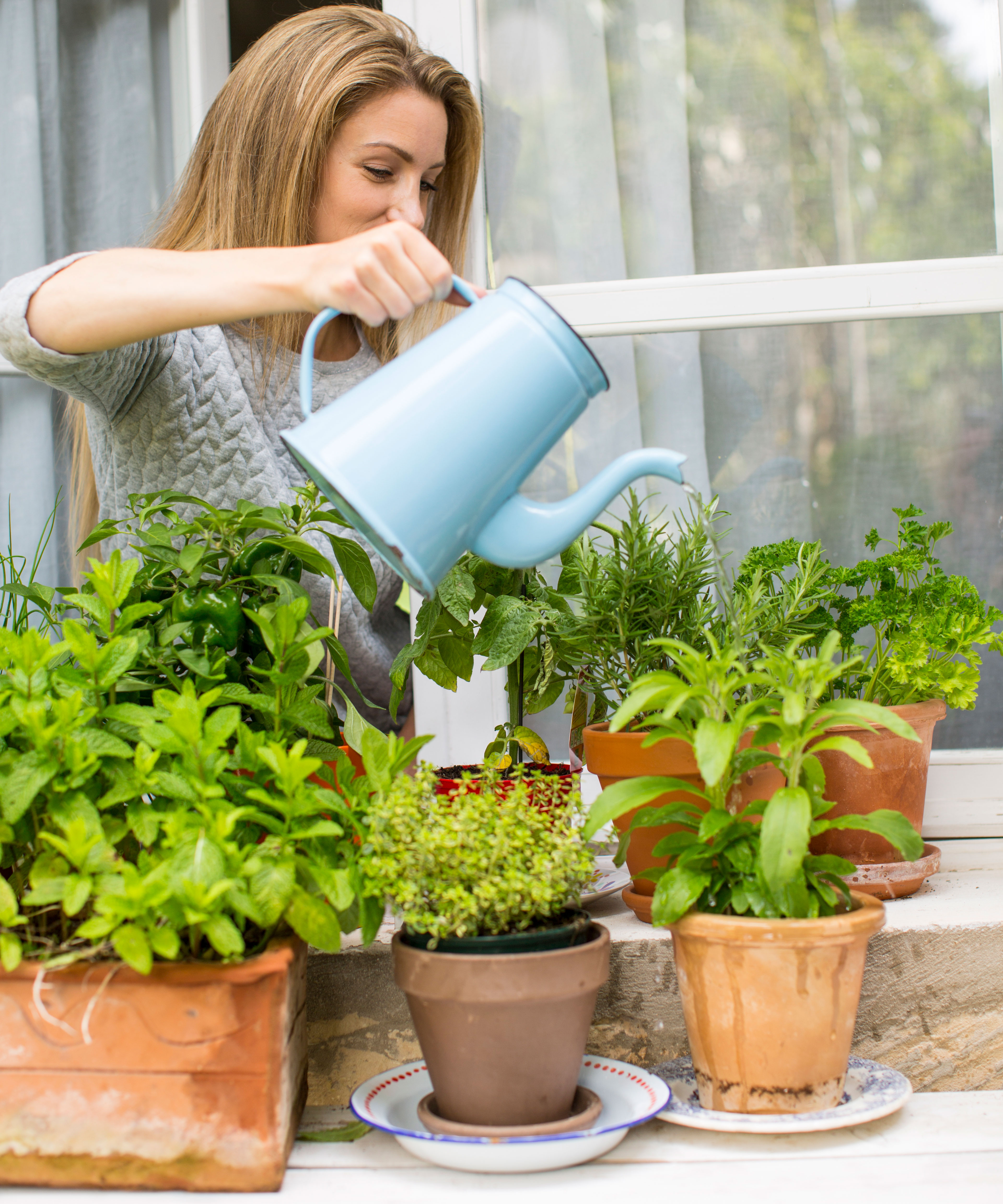
How do I grow herbs on my windowsill?
To grow herbs on a windowsill, 'allow the top inch of soil to dry between watering to help prevent fungus gnats and diseases. Rotate the pots regularly, so that the plants don't lean towards the light, and water with room temperature water,' advises Shannon Caringi of Trillium Living.
Growing herbs indoors using individual containers is best, so each plant can be put in the best growing conditions.
'If you want to create mixed windowsill herb garden, however, select containers that are 10-12in in diameter, or a window box. It is important to combine herbs that have the same light needs and water requirements,' advises Amy.
Think about the care the individual herbs need. 'Rosemary, thyme and sage like fairly dry soil so they make a good container combination. Whereas parsley and basil need more moisture, so they can also be planted in the same pot,' advises Claire Ransom from online plant subscription box LazyFlora, which provides edible herb bundles.
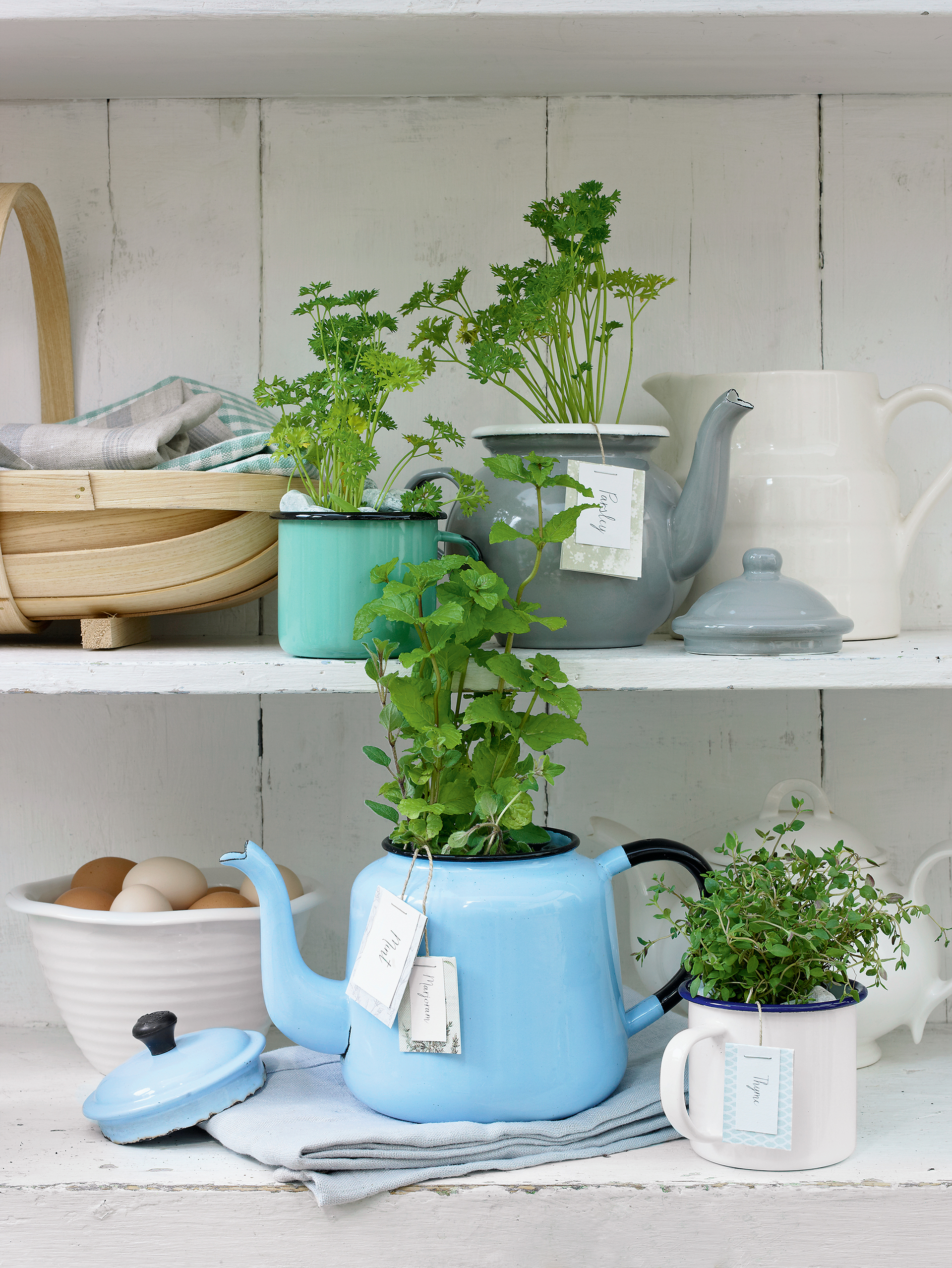
Do indoor herbs need direct sunlight?
Herbs need as much direct sunlight or natural light as possible to thrive indoors.
'They should be grown in a bright, sunny spot like a window that faces south and receives at least six hours of sunlight each day. Even partial shade herbs should be grown in the brightest spot possible indoors,' says Amy.
'Most herbs love a sunny windowsill so when you can, plant them south facing. They will still grow elsewhere but not as quickly,' advises Claire Ransom from online plant subscription box LazyFlora, which provides edible herb bundles.
If you do not have any south-facing windows, then 'mint, parsley and chives will thrive with less intense light and do prefer slightly cooler temperatures,' says Claire.
Signs that your indoor herb garden is not receiving enough light include:
- Poor growth.
- Abnormally long stems between leaf sets.
- Leaves that are pale or turn yellow.
If you see any of these signs with your indoor herbs then try to move them to a different location where they will receive more sunlight.
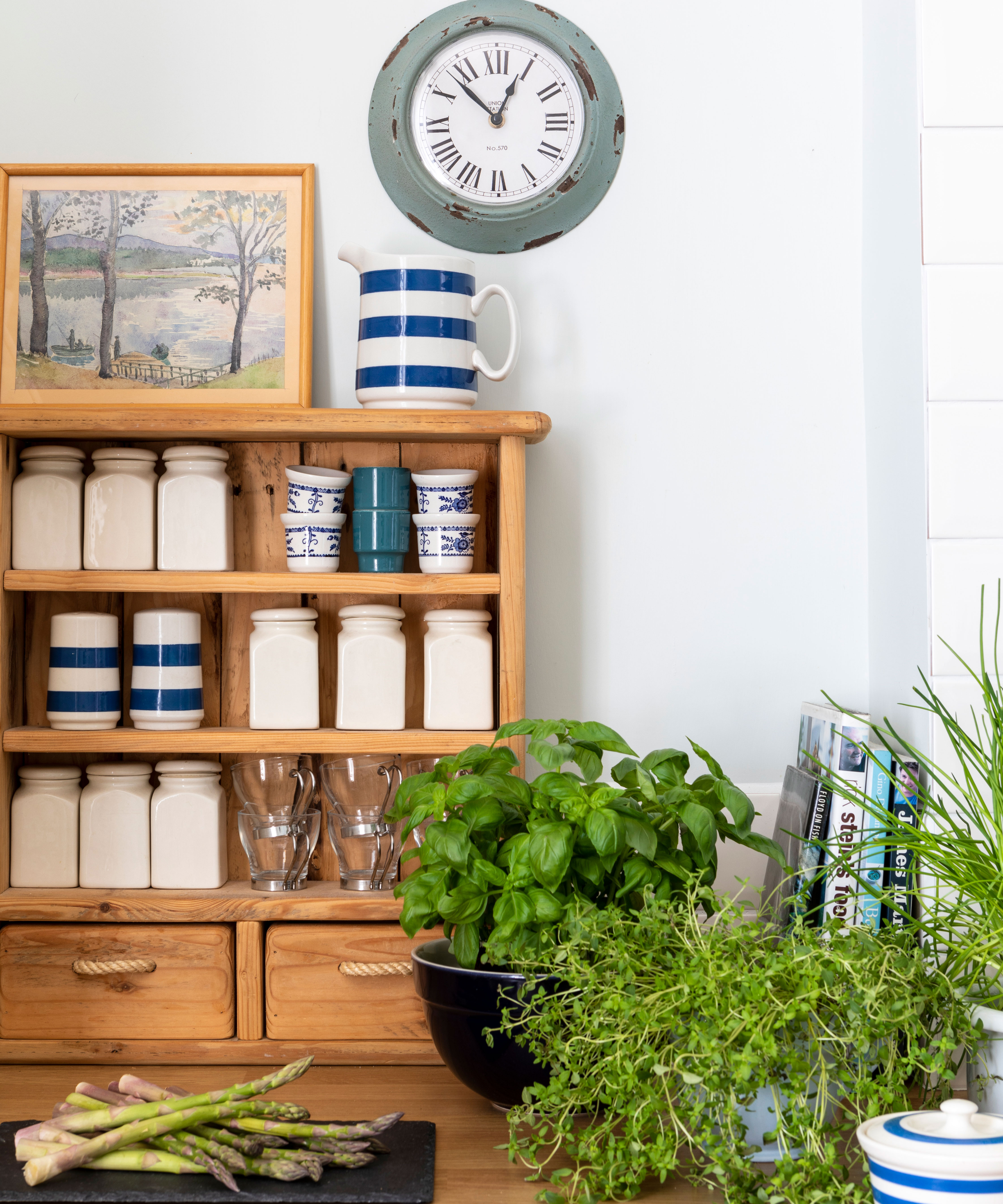
Can herbs be grown indoors year round?
Herbs can be grown indoors year round, however in winter, when natural sunlight is reduced, it can be harder growing herbs indoors on even the sunniest south-facing windowsills.
'During the winter in northern climates, windowsills may be 15 to 30 degrees colder than the room’s temperature, which could slow growth and cause plants to struggle,' says Shannon Caringi.
'However, if you grow the herbs under grow lights to provide supplemental light, all herbs can be successfully grown indoors,' says Amy Enfield.
These specialty lights mimic direct sunlight to provide full nourishment to plants.
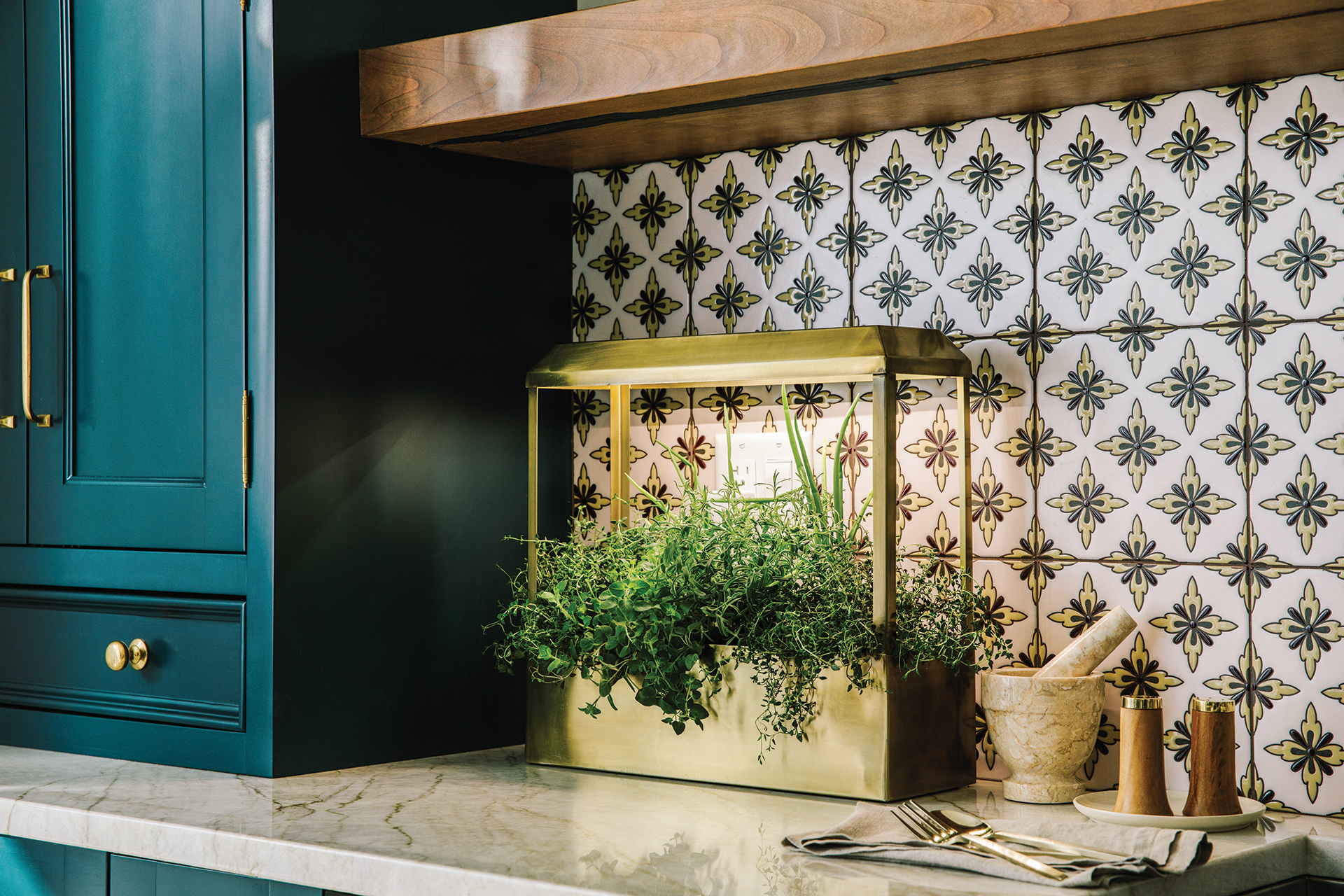
There are many different indoor herb planter kits available, such as the Smart Garden systems from Click And Grow that provide automated light, watering and nutrients and enable you to keep growing herbs indoors all year round.
How do you keep herbs alive indoors?
To keep herbs alive indoors and also ensure that leaves are available for when you need them for cooking or making infusions or tisanes, they need to be lightly trimmed regularly.
'A light trim once a week, or every other week depending on how fast your plant is growing, will keep your herbs from flowering, which can alter their flavor, and not always in a good way,' says Amy.
Trimming the indoor herb plants will also encourage new, young growth to form.
'When you trim your herbs, you should never remove more than a third of the plant in a single harvest,' Amy adds.
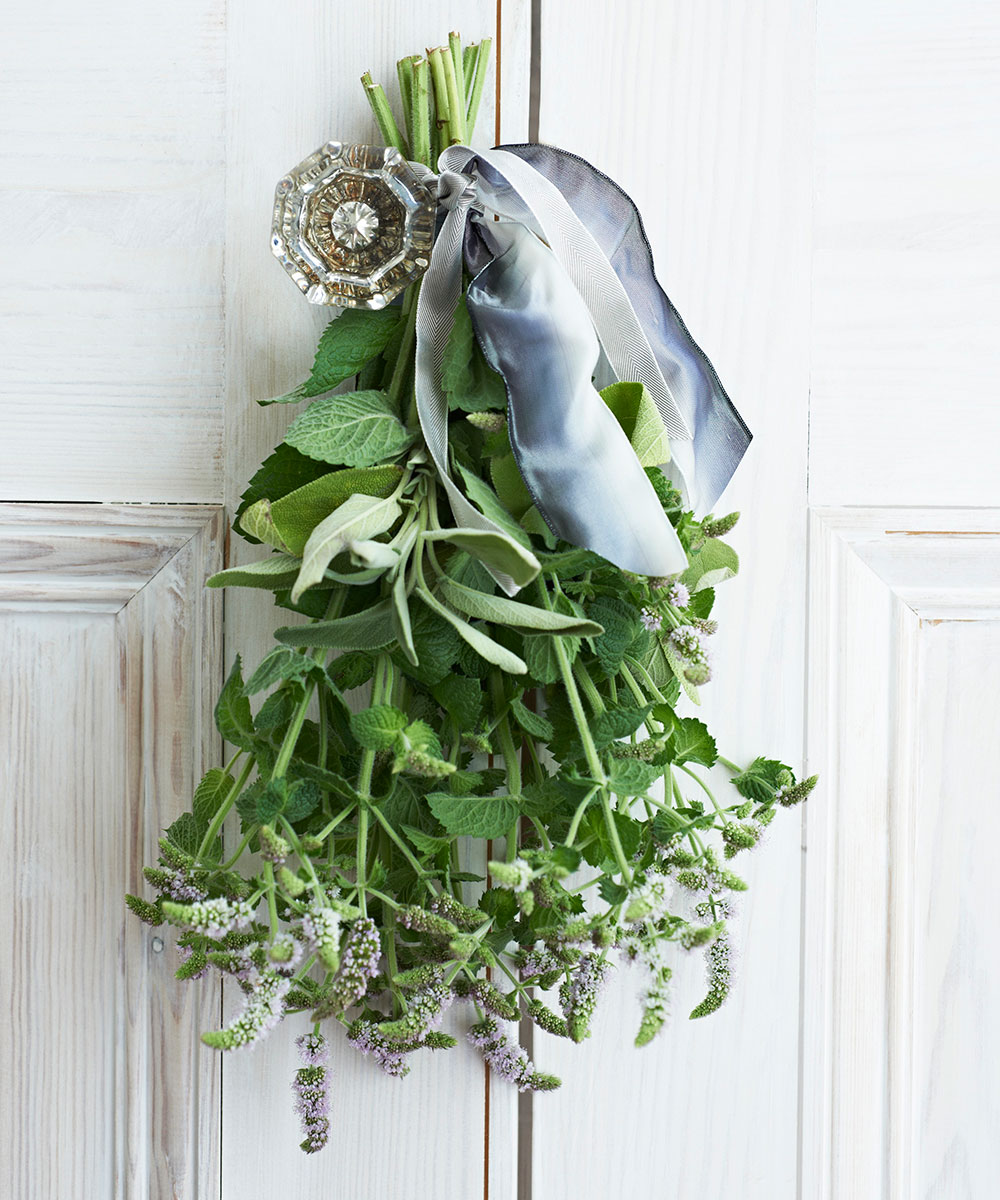
How often should I water my indoor herbs?
You should not water indoor herbs too much. Each herb has its own watering needs, so check these, although generally none like sitting in soggy soil.
'Some people love their plants too much and water them everyday, while other people neglect their windowsill herb garden just a little too much and never water them at all,' says Amy Enfield.
The right way to water is somewhere in the middle. Your herbs should be watered when the top inch of soil becomes dry.
'The easiest way to test this is by gently sticking your finger into the soil either daily or every other day. If the soil still feels cool and damp, wait to water, but if the soil is dry, it’s time to give them a drink,' Amy advises.
Top tip: When you water your indoor herbs, water them thoroughly. Saturate the soil and allow the excess water to drain away.
Remove any standing water in the water collection trays that remains 20 minutes after watering to prevent root rot.

How can you grow herbs indoors from seed?
One of the most cost-effective ways of growing herbs indoors is to start them off from seed, but this approach will require some patience.
Some herbs, such as basil, cilantro (coriander) and chervil, are, in fact, best started from seed and replanted throughout the year.
'The benefit from starting your herbs from seed is that you have a wider variety of herbs to choose from and may be a good option if you want to grow a lot of one type of herb in a windowsill herb garden,' says Amy.
However, do bear in mind that many herbs can take a long time to grow from seed. Therefore you may prefer to start with a combination of young plants, for immediate harvesting, and then sow seeds successionally for herbs to enjoy throughout the year.
To grow herbs indoors from seed, start your herb seeds off in small pots or seed trays of moist, peat-free multi-purpose compost.
- Do not sow too many herb seeds as most will germinate, so sow what you need.
- Cover the seeds with a thin layer of soil and water lightly.
- Use a propagator or cover the pot with a plastic bag secured with an elastic band to increase the temperature.
- When the herb seeds have germinated, remove the covering, and keep the compost moist.
- Thin out seedlings so that each one has the space to grow healthily.
- When the seedlings have developed their first true leaves and are large enough to handle, plant them on into 6in pots.
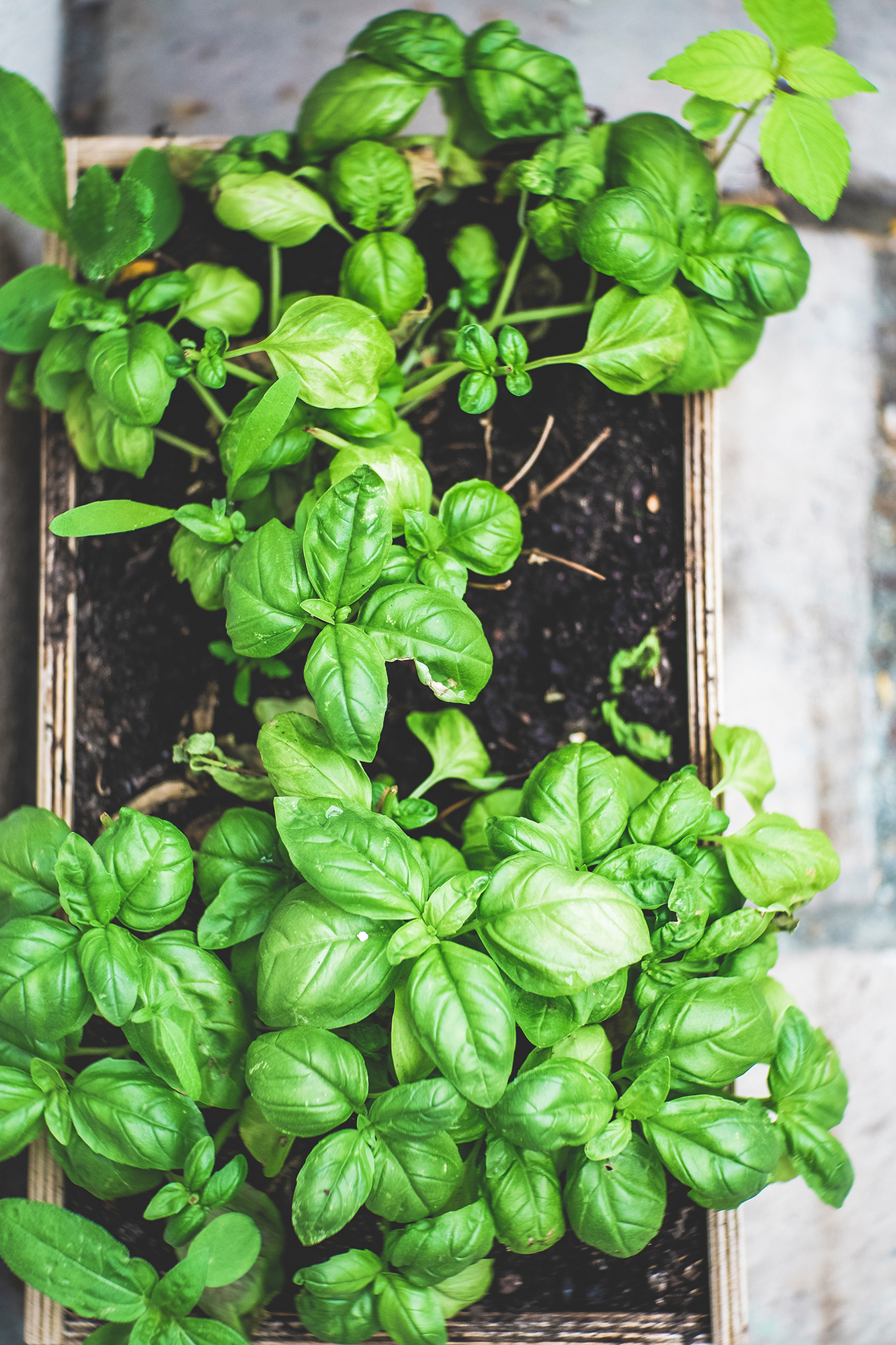
How do you grow herbs indoors from cuttings?
You can grow many shrubby or woody herbs indoors from cuttings. These include rosemary, thyme, lavender, sage, bay, marjoram and oregano.
You can either take softwood cuttings in spring, or semi-ripe cuttings in late summer or fall.
To take softwood herb cuttings in spring:
- Take cuttings in the morning when the plant is full of water.
- Look for new side-shoots that don’t carry flower-buds.
- Using a sharp knife or secateurs, cut just below the leaf node - where a leaf is joined to the stem.
- Cut at an angle.
- Trim the cuttings to about 2-4 inches long.
- Take more cuttings than you want – to allow for failures.
- Fill a pot with an equal amount of potting compost and horticultural sand or perlite, and make a hole with a dibber or pencil.
- Plant the cuttings in the pot and firm the soil around them.
- Water and place in a propagator or cover with a plastic bag secured with an elastic band.
- Place on a sunny windowsill and keep the compost moist.
- Remove from the propagator or remove the plastic bag once you seen signs of growth – usually about 3 to 4 weeks.
To take semi-ripe herb cuttings in late summer or fall:
- Select cuttings from this season’s growth.
- Using a sharp knife or secateurs, cut just below the leaf node.
- Trim the cuttings to about 4-6in long.
- Remove the lowest leaves.
- Dip the bottom of the cutting in fresh hormone rooting powder, and remove the excess.
- Then plant into pots as above with softwood cuttings.
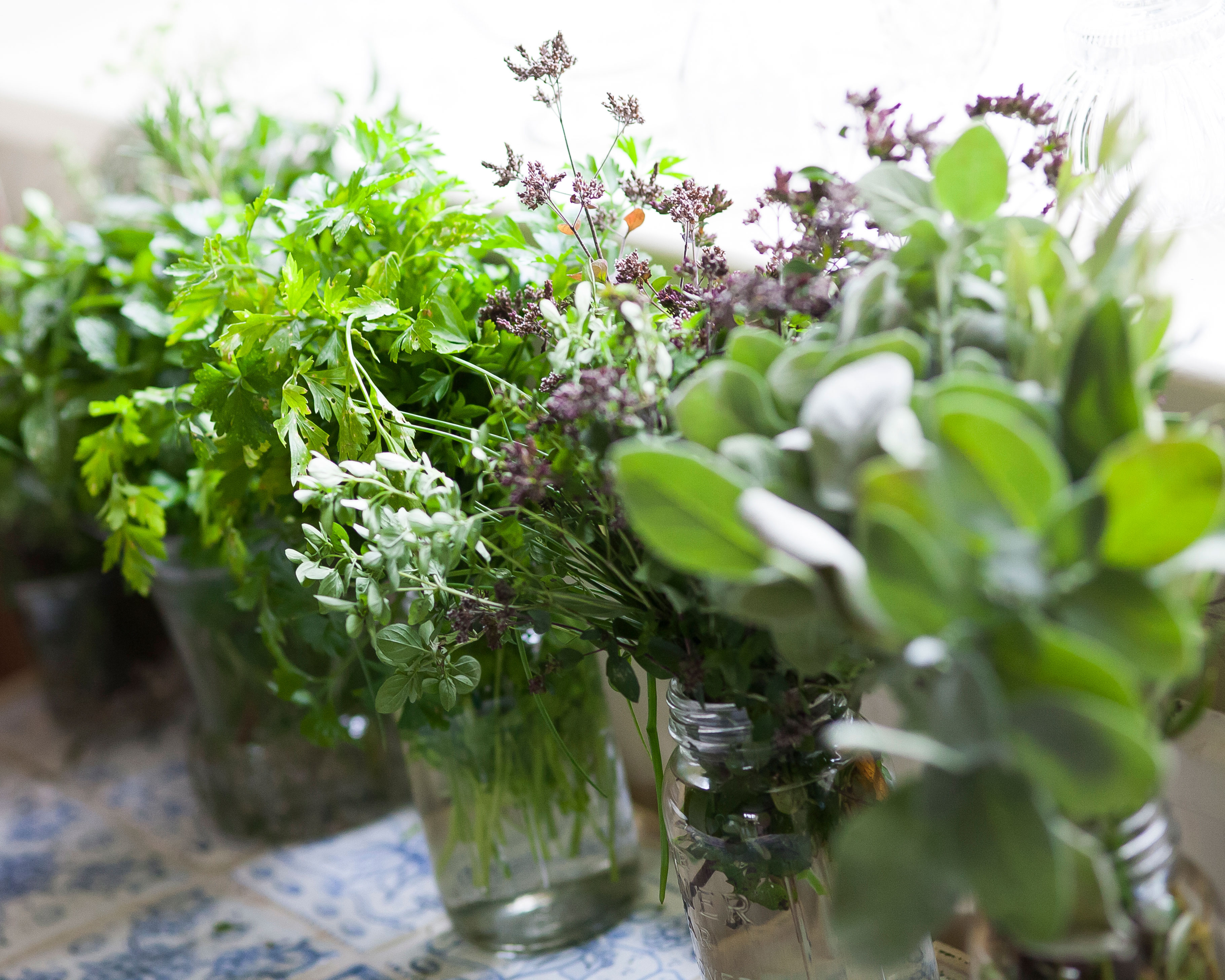
Can you try growing herbs indoors in water?
There are some herbs that can be grown indoors in water, without soil.
Stems of perennial herbs, such as sage, thyme, mint, basil and oregano, will happily grow roots in glasses or jars of plain water.
You can create an attractive kitchen windowsill herb garden display using kilner or jam jars filled with herb plants to use for cooking, all year round.
To grow herbs in water indoors:
- Cut some stems off herb plants you're already growing, or herbs you have bought from the supermarket, and trim them to about 6in long.
- Remove the leaves from the bottom 4in.
- Cut the bottom of the stem at an angle so it can absorb more water.
- Fill a large-mouthed jar or glass with clear water from the tap or bottle, but avoid distilled water.
- Ideally use opaque glass as clear glass will need more regular cleaning as algae will form quicker on it.
- Place the herb stems in the jars and place on a sunny – preferably south-facing windowsill.
- Harvest each leaf as it grows to full size to encourage the stem to produce more leaves.
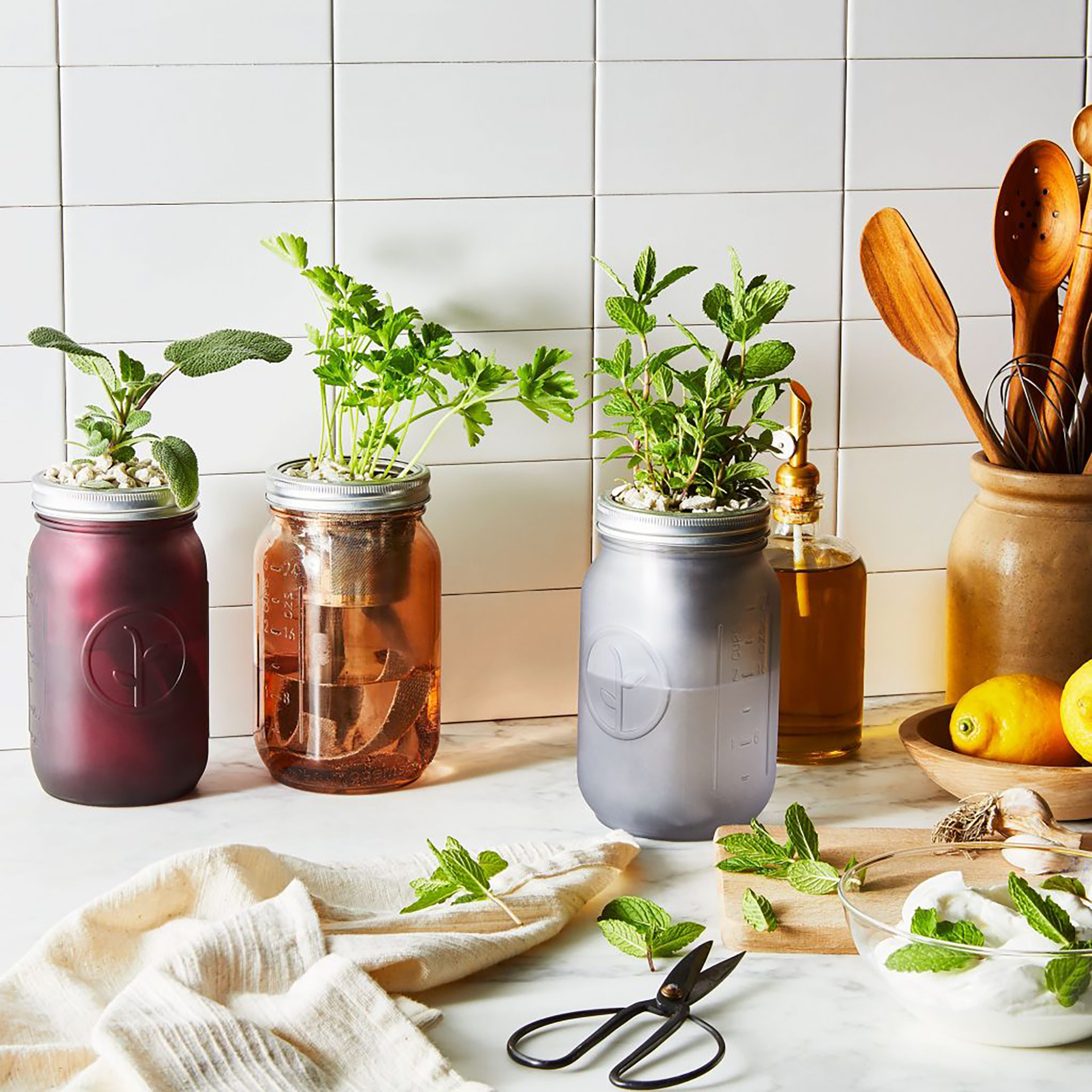
This feature was created by H&G sister brand, Period Living magazine
Subscribe to Period Living magazine for more inspiration
Period Living is the UK's best-selling period homes magazine. A subscription provides you with all you need to know about caring for and improving a traditional house and garden.
Rachel is senior content editor, and writes gardening content for homesandgardens.com, Homes & Gardens magazine, and its sister titles Period Living Magazine and Country Homes & Interiors. She has written for lifestyle magazines for many years, with a particular focus on gardening, historic houses and arts and crafts, but started out her journalism career in BBC radio, where she enjoyed reporting on and writing programme scripts for all manner of stories. Rachel then moved into regional lifestyle magazines, where the topics she wrote about, and people she interviewed, were as varied and eclectic as they were on radio. Always harboring a passion for homes and gardens, she jumped at the opportunity to work on The English Home and The English Garden magazines for a number of years, before joining the Period Living team.

